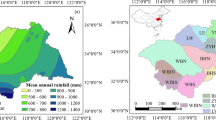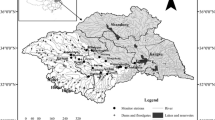Abstract
This study investigated the long-term stream water quality trends of nine catchments in Hong Kong with different levels of urbanization using monthly water quality data for a 30-year period at annual and seasonal (wet and dry) scales. Raw data were modeled using redundancy analysis and Mann–Kendall test. Only one river showed a clear difference of water quality responses between the upstream and downstream monitoring stations. Nevertheless, in general, water quality of monitoring stations that had built areas less than 40% showed improving trends, whereas their downstream counterparts with built areas more than 70% showed deterioration trends for some parameters. Majority of water quality trends were season-independent. Out of the variables that were indicative of a long-term deterioration trend, total solids, total suspended solids, turbidity and electrical conductivity (all surrogates of sediment load of the river) were prominent. Nitrate concentration demonstrated an increasing trend for most streams, whereas phosphates a decreasing trend. This study concluded that the main source of pollution could be the surface runoff (nonpoint sources), not the wastewater inputs (point sources). Stream discharge was increasing and decreasing in the downstream and upstream stations, respectively. This could be attributed to the increase in imperviousness in the downstream and water extraction in the upstream. The downstream discharge increment with time would also support the fact that contamination was due to surface runoff. This study provides evidence that the Hong Kong legislative control actions on point source pollution work well, but not on nonpoint source pollution.







Similar content being viewed by others
References
Angelidis, M. O., Markantonatos, P. G., & Bacalis, N. C. (1995). Impact of human activities on the quality of river water: the case of Evrotas River catchment basin, Greece. Environmental Monitoring and Assessment, 35(2), 137–153.
Cai, M., Schwartz, J. S., Robinson, R. B., Moore, S. E., & Kulp, M. A. (2011). Long-term annual and seasonal patterns of acidic deposition and stream water quality in a Great Smoky Mountains high-elevation watershed. Water, Air, & Soil Pollution, 219(1–4), 547–562.
Dawood, M. (2017). Spatio-statistical analysis of temperature fluctuation using Mann–Kendall and Sen’s slope approach. Climate Dynamics, 48(3–4), 783–797.
Dueñas, J. F., Alonso, J. R., Rey, À. F., & Ferrer, A. S. (2003). Characterisation of phosphorous forms in wastewater treatment plants. Journal of Hazardous Materials, 97(1–3), 193–205.
Gilbert, R. O. (1987). Statistical methods for environmental pollution monitoring. Wiley.
Glińska-Lewczuk, K., Gołaś, I., Koc, J., Gotkowska-Płachta, A., Harnisz, M., & Rochwerger, A. (2016). The impact of urban areas on the water quality gradient along a lowland river. Environmental Monitoring and Assessment, 188(11), 624.
Gomes, P. I.A, & Asaeda, T. (2009). Spatial and temporal heterogeneity of Eragrostis curvula in the downstream flood meadow of a regulated river. Annales de Limnologie-International Journal of Limnology 45 (3), 181–193.
Gomes, P. I. A., Wai, O. W. H., Kularatne, R. K. A., Priyankara, T. D. P., Anojika, K. G. M. S., & Kumari, G. M. N. R. (2014). Relationships between disturbance representative riparian and non-riparian herbaceous indicators (biomass and diversity) and lotic water quality: applicability of herb intensive strategies on rehabilitation of lotic waters. Water, Air, & Soil Pollution, 225(9), 1–18. https://doi.org/10.1007/s11270-014-2060-4.
Gomes, P. I. A., Fernando, B. A. V. W., & Dehini, G. K. (2019). Assessment of pollution sources, fate of pollutants, and potential instream interventions to mitigate pollution of earthen canals of urban to rural-urban fringe. Water, Air, & Soil Pollution, 230(11), 262.
Gomes, P. I. A, Wai, O. W. H, & Yan, X. F. (2017). Eco‐hydraulic evaluation of herbaceous ecosystems below headwater dams without a base flow: Observing below dam reaches as new stream sources. Ecohydrology, 10(1), e1774.
Hirsch, R. M., Alexander, R. B., & Smith, R. A. (1991). Selection of methods for the detection and estimation of trends in water quality. Water Resources Research, 27(5), 803–813.
Hurlbert, S. H. (1984). Pseudoreplication and the design of ecological field experiments. Ecological Monographs, 54(2), 187–211.
Imaizumi, F., & Sidle, R. C. (2007). Linkage of sediment supply and transport processes in Miyagawa Dam catchment, Japan. Journal of Geophysical Research: Earth Surface, 112(F3).
Jaagus, J. (2006). Climatic changes in Estonia during the second half of the 20th century in relationship with changes in large-scale atmospheric circulation. Theoretical and Applied Climatology, 83(1–4), 77–88.
Lands Department, Hong Kong (2018) https://www.landsd.gov.hk/ Accessed 12 Jan 2018.
Miller, J. D., Schoonover, J. E., Williard, K. W., & Hwang, C. R. (2011). Whole catchment land cover effects on water quality in the lower Kaskaskia River watershed. Water, Air, & Soil Pollution, 221(1-4), 337.
Morrison, G., Fatoki, O. S., Persson, L., & Ekberg, A. (2001). Assessment of the impact of point source pollution from the Keiskammahoek Sewage Treatment Plant on the Keiskamma River-pH, electrical conductivity, oxygen-demanding substance (COD) and nutrients. Water SA, 27(4), 475–480.
Mouri, G., Takizawa, S., & Oki, T. (2011). Spatial and temporal variation in nutrient parameters in stream water in a rural-urban catchment, Shikoku, Japan: effects of land cover and human impact. Journal of Environmental Management, 92(7), 1837–1848.
Naddafi, K., Honari, H., & Ahmadi, M. (2007). Water quality trend analysis for the Karoon River in Iran. Environmental monitoring and assessment, 134(1-3), 305-312.
Parrish, D. D., Singh, H. B., Molina, L., & Madronich, S. (2011). Air quality progress in North American megacities: a review. Atmospheric Environment, 45(39), 7015–7025.
Pinto, U., Maheshwari, B. L., & Ollerton, R. L. (2013). Analysis of long-term water quality for effective river health monitoring in peri-urban landscapes—a case study of the Hawkesbury–Nepean river system in NSW, Australia. Environmental Monitoring and Assessment, 185(6), 4551–4569.
Russell, K. L., Vietz, G. J., & Fletcher, T. D. (2019). Urban sediment supply to streams from hillslope sources. Science of the Total Environment, 653, 684–697.
Smith, R. A., Alexander, R. B., & Wolman, M. G. (1987). Water-quality trends in the nation’s rivers. Science, 235(4796), 1607–1615.
Sobota, D. J., Compton, J. E., McCrackin, M. L., & Singh, S. (2015). Cost of reactive nitrogen release from human activities to the environment in the United States. Environmental Research Letters, 10(2), 025006.
Tanos, P., Kovács, J., Kovács, S., Anda, A., & Hatvani, I. G. (2015). Optimization of the monitoring network on the River Tisza (Central Europe, Hungary) using combined cluster and discriminant analysis, taking seasonality into account. Environmental Monitoring and Assessment, 187(9), 575.
Tavakol, M., Arjmandi, R., Shayeghi, M., Monavari, S. M., & Karbassi, A. (2017). Develo** an environmental water quality monitoring program for Haraz River in Northern Iran. Environmental Monitoring and Assessment, 189(8), 410.
Ter Braak, C. J. F., & Šmilauer, P. (2002). CANOCO Reference Manual and CanoDraw for Windows User’s Guide (4.5). Ithaka, NY: Microcomputer Power.
Thodsen, H., Rasmussen, J. J., Kronvang, B., Andersen, H. E., Nielsen, A., & Larsen, S. E. (2019). Suspended matter and associated contaminants in Danish streams: a national analysis. Journal of Soils and Sediments, 1–15.
USGS (2020) https://www.usgs.gov/special-topic/water-science-school/science/urbanization-and-water-quality?qt-science_center_objects=0#qt-science_center_objects. Accessed 20 May 20203
Van den Brink, P. J., & Ter Braak, C. J. (1999). Principal response curves: analysis of time-dependent multivariate responses of biological community to stress. Environmental Toxicology and Chemistry, 18(2), 138–148.
Walsh, C. J., Roy, A. H., Feminella, J. W., Cottingham, P. D., Groffman, P. M., & Morgan, R. P. (2005). The urban stream syndrome: current knowledge and the search for a cure. Journal of the North American Benthological Society, 24(3), 706–723.
Wang, Y. B., Liu, C. W., Liao, P. Y., & Lee, J. J. (2014). Spatial pattern assessment of river water quality: implications of reducing the number of monitoring stations and chemical parameters. Environmental Monitoring and Assessment, 186(3), 1781–1792.
Xu, J., Yin, K., Lee, J. H., Liu, H., Ho, A. Y., Yuan, X., & Harrison, P. J. (2010). Long-term and seasonal changes in nutrients, phytoplankton biomass, and dissolved oxygen in Deep Bay, Hong Kong. Estuaries and Coasts, 33(2), 399–416.
Yung, Y. K., Wong, C. K., Yau, K., & Qian, P. Y. (2001). Long-term changes in water quality and phytoplankton characteristics in Port Shelter, Hong Kong, from 1988–1998. Marine Pollution Bulletin, 42(10), 981–992.
Zhou, F., Liu, Y., & Guo, H. (2007). Application of multivariate statistical methods to water quality assessment of the watercourses in Northwestern New Territories, Hong Kong. Environmental Monitoring and Assessment, 132(1–3), 1–13.
Acknowledgements
This research was funded by the Research Grants Council Fund of Hong Kong (Project number: PolyU152161/14E) and the Environment and Conservation Fund, Hong Kong (Project number: 39/2011).
Author information
Authors and Affiliations
Corresponding author
Additional information
Publisher’s Note
Springer Nature remains neutral with regard to jurisdictional claims in published maps and institutional affiliations.
Rights and permissions
About this article
Cite this article
Gomes, P.I.A., Wai, O.W.H. Investigation of Long-Term River Water Quality Trends in Hong Kong to Identify Role of Urbanization, Seasons and Pollution Sources. Water Air Soil Pollut 231, 378 (2020). https://doi.org/10.1007/s11270-020-04753-1
Received:
Accepted:
Published:
DOI: https://doi.org/10.1007/s11270-020-04753-1




